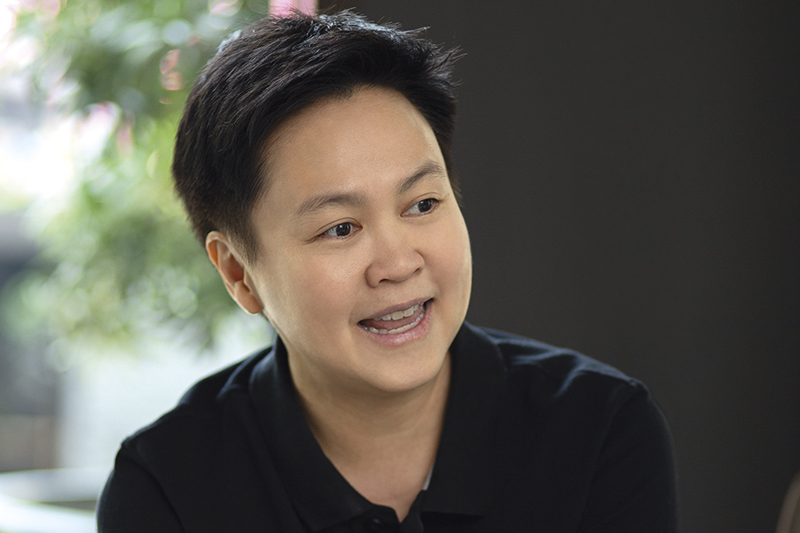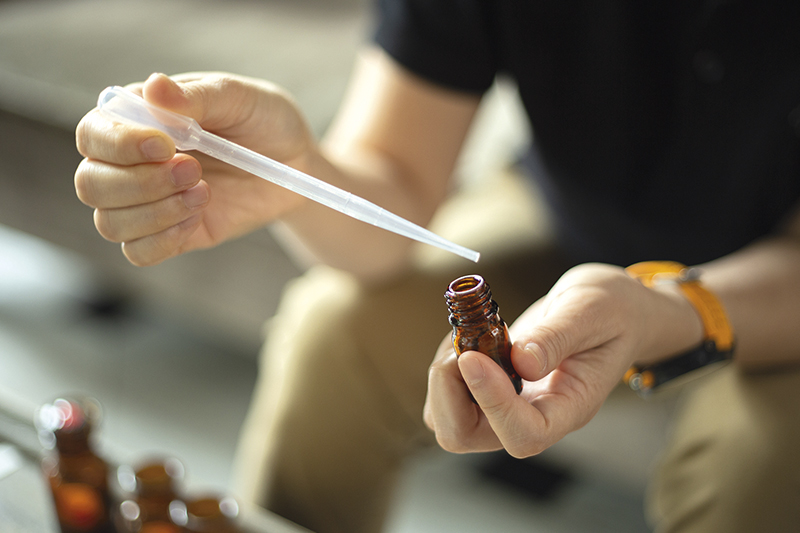
Sniffing Success
A scent ‘architect’, Chalida Kunalai has designed everything from hotel ambience to colours for the blind.
Words: Khetsirin Pholdhampalit
Photos: Suwit Kittitien
Chalida Kunalai has been sniffing out opportunities all her working life. The professional scent designer has created pleasant fragrances for consumer products – like rose-smelling laundry detergent and green tea-scented dishwashing liquid – as well as the bad smells of a gas leak, burning and sour milk to warn blind people about dangers.
“Our sense of smell is a human instinct and is closely linked with memory and experience. a whiff of cologne in a department store can remind you of an ex-boyfriend who wore the same scent,” grinds Chalida, who has been in the scent business for 30 years. “Fragrance can also add a layer to your personal identify, like invisible clothing. That’s why we use the phrase ‘wear perfume’. Smell is thus a powerful and creative form of communication related to emotion and experience.”
Chalida, who looks far younger than her 50 years, got her first sniff of the scent business three decades ago when she landed a job as an account executive for a perfume house. The role taught her plenty about the art of fragrance.
“A scent designer works closely with a perfumer. I am the ‘architect’ who creates plans that are used to make something, while a perfumer is the engineer who takes those plans and makes them practical and usable,” says Chalida, who graduated in political science and mass communication.
After working in the perfume house for 10 years, she moved on to designing fragrances for Asian consumer products – a role she has filled for the past 20 years. Her task is a challenging one: to create scents that can be infused in goods that will appeal to different lifestyles and cultures of countries across Asia.
“For instance, Chinese food normally doesn’t have strong flavours, so Chinese people prefer light and natural odours to strong-smelling scents. On the contrary, we can’t use light, pleasant odours for goods sold in India because Indians have noses that are familiar with intense spices. Thai people, meanwhile, like floral and fruity scents such as lavender and apple,” says Chalida, whose nose was “educated” at courses on perfume she took in France during which she learned more about sensory perception and the raw materials of fragrances.

Apart from her everyday work designing fragrances for consumer products, Chalida loves to experiment and try new things. She has created chocolate-scented oil for wine and edible pepper-smelling oil to flavour Western dishes for a restaurant and wine bar.
“Wine and perfume speak the same language – both have fruity, spicy and light – or full-bodied characteristics. Most people love both wine and chocolate, so I experimented and combined them to make a signature drink. It received a lot of positive feedback from customers. Meanwhile, some people like peppery smells but not spicy tastes. So I realised an edible pepper-smelling oil that can be infused in the food could meet that need,” she says.
Chalida also designed the scented ambience for a luxury hotel, after being instructed to deliver the key messages of “sophisticated”, “luxury”, “innovative” and “avid traveller”.
“Using a set of fragrant oils, my task is to combine this and that to discover the right scent that communicates those key messages to the hotel’s clients. It is similar to an artist who has to create a painting from a palette of available colours,” she says.
Her deep knowledge of scent design also landed Chalida a place among the speakers at 2015 TEDxBangkok. The forum for innovative thinkers gave her opportunities to integrate her expertise with masters in various fields – from scientists, tech artists and therapists to performers, storytellers and children’s book writers.

In 2016, Chalida collaborated with brain scientist Assoc. Prof Yodchanan Wongsawat, from Mahidol University’s Biomedical Engineering Department, to create a conceptual art installation titled “Brain Smells” aimed at visualising how the brain is stimulated by various smells.
She designed three scents to evoke different emotions and experiences. One scent evoked nature with an odour of grass, while the others recalled candy and the smell of burning. Electrodes were attached to the heads of participants and connected up to a computer. When the prepared scents were inhaled by participants and processed in the brain, the computer recorded the brainwave frequencies and interpreted them as emotions. It then assigned a separate colour for each emotion, drops of which were directed onto pools of white milk serving as a liquid canvas.
“Blue was associated with nature and relaxation [the grass scent], while yellow represented childhood memory [candy]. Red reflected an alert and focused state of mind [burning]. These colours were real-time visual representations of the brain’s processing of information. The results varied, depending on each subject’s memory and experience of the scent. We aimed to present, visually, how smells have an influence on the human brain – and open up ways this could be applied in various fields such as healthcare, education, art and design,” she explains.

Next, Chalida set out to empower blind people by handing them the tools to express themselves through art. Two years ago she created a set of scented acrylic colours for the “Nose Project” in collaboration with therapist Zign Tancharoen and Kris Sanguanpiyapand, co-founder of the Blind Theatre.
“My intention was to create a set of different scents that evoke the same feeling as seeing certain colours. It talked to the art therapist [Zign] and blind people about the meaning and the feeling of each colour. I then designed scents to signify the five primary colours – white, black, yellow, blue and red. For instance, red represented sun and power, so I made a spicy smell. Black was evoked with a stale-smelling scent,” Chalida says. “It turned out that the blind people could create impressive artworks with the help of the scented colours.”
Chalida never runs out of ideas in exploring the power of scents. Recently, she has been working with writers of children’s books and partners from the Nose Project to create a set of scented children’s books to be distributed to schools for the blind as educational kits.
The set has three volumes of four books each that come with bottles of scent that match the stories. The first volume contains tales to alert the visually impaired children about household dangers like gas leaks and electric shocks. The odours are designed to match such hazards. The second volume deals with air pollution outside the house, including fumes from exhaust pipes and cigarette smoke that they should steer clear of.
“The last volume is all about adventure and aims to encourage them to explore the world outside. I plan to design scents that evoke snow, waterfalls and the sea,” says Chalida, who hopes to complete the project in the next six months.

ชลิดา คุณาลัย นักออกแบบกลิ่นมืออาชีพที่รังสรรค์ตั้งแต่กลิ่นกุหลาบแต่งกลิ่นผงซักฟอก น้ำยาล้างจานกลิ่นชาเขียว หรือแม้แต่กลิ่นเหม็นฉุนของแก๊สเพื่อเตือนอันตรายแก่ผู้พิการทางสายตา
ประสบการณ์อันยาวนานกว่า 30 ปี ในฐานะนักออกแบบกลิ่นทำให้เธอได้เรียนรู้ทุกแง่มุมของธุรกิจและศาสตร์แห่งกลิ่น เธอเปรียบเสมือนสถาปนิกที่ออกแบบแปลนให้แก่นักปรุงน้ำหอมผู้เป็นดั่งวิศวกร และทำให้เธอรู้ว่า ประสาทสัมผัสทางจมูกเชื่อมโยงกลิ่นเข้ากับประสบการณ์และความทรงจำของแต่ละคน น้ำหอมจึงเป็นเครื่องมือแสดงถึงอัตลักษณ์เพื่อสื่อถึงอารมณ์และประสบการณ์ในอีกทางหนึ่ง
หลังจากร่วมงานกับแบรนด์น้ำหอมมาร่วม 10 ปี ชลิดาก็ได้ย้ายมาทำงานออกแบบกลิ่นหอมสำหรับผลิตภัณฑ์แก่ผู้บริโภคเอเชียในช่วง 20 ปีหลัง เธอได้พบกับความท้าทายในการออกแบบกลิ่นที่ “เหมาะสม” เพื่อผสมผสานเข้ากับสินค้าต่างๆ ตามวิถีชีวิตและวัฒนธรรมของคนในชาตินั้นๆ ชาวจีนไม่ชอบอาหารรสจัดเช่นเดียวกับกลิ่นที่ต้องไม่แรงฉุน ตรงข้ามกับชาวอินเดียที่ชื่นชอบเครื่องเทศ จึงชอบกลิ่นที่อบอวลกว่า ส่วนคนไทยชื่นชอบกลิ่นดอกไม้และผลไม้มากกว่ากลิ่นอื่นๆ
ความท้าทายนี้เองที่ทำให้เธอหลงใหลการทดลองสร้างกลิ่นใหม่ๆ ไม่ว่าจะเป็นน้ำมันกลิ่นช็อกโกแลตเพื่อผสมในไวน์และน้ำมันกลิ่นพริกไทยเพื่อผสมกับอาหารในร้านอาหารและไวน์บาร์ชื่อดัง จนเป็นที่ชื่นชอบอย่างมาก
นอกจากนี้ เธอยังได้รับโจทย์ให้ออกแบบกลิ่นที่สื่อสาร “ความซับซ้อน” “ความหรูหรา” “ความแปลกใหม่” และ “ความหลงใหลในการท่องเที่ยว” สำหรับโรงแรมหรู ชลิดากล่าวว่า เธอเป็นเหมือนกับศิลปินที่ต้องวาดภาพตามสีสันที่มีอยู่เพื่อให้เป็นภาพวาดตามที่ลูกค้าปรารถนา
ในปี 2558 เธอได้รับเชิญไปบรรยายบนเวที TEDxBangkok ซึ่งเปิดโอกาสให้เธอได้แบ่งปันความรู้กับผู้เชี่ยวชาญหลากหลายแขนง จนได้มีโอกาสร่วมงานกับ ผศ. ดร. ยศชนัน วงศ์สวัสดิ์ จากภาควิชาวิศวกรรมชีวเวช มหาวิทยาลัยมหิดล และ Bit Studio สร้างผลงานศิลปะจัดวางคอนเซ็ปชวล ชื่อ “Brain Smells” เพื่อแสดงภาพปฏิกิริยาของสมองที่มีต่อกลิ่นต่างๆ
เธอออกแบบกลิ่นธรรมชาติ กลิ่นลูกกวาด และกลิ่นไหม้ เมื่อผู้เข้าชมนิทรรศการได้ดมกลิ่นแต่ละกลิ่น คลื่นไฟฟ้าจากสมองจะส่งผ่านอิเล็กโทรดแปลงความถี่เป็นหยดสีที่มีความเกี่ยวเนื่องกับอารมณ์ แล้วหยดลงบนอ่างน้ำนมสีขาวที่ทำหน้าทีเป็นผืนผ้าแคนวาส
สีที่ได้จะแตกต่างกันออกไปตามความรับรู้และประสบการณ์ของผู้ชมศิลปะแต่ละคนทีมีต่อกลิ่นนั้นๆ งานศิลปะครั้งนี้ต้องการแสดงให้เห็นว่ากลิ่นมีอิทธิพลต่อสมองและการแปรความของมนุษย์อย่างไร
ชลิดายังได้ทำงานร่วมกับคุณทราย ตันเจริญ และคุณกฤษณ์ สงวนปิยะพันธ์ ผู้ก่อตั้ง Blind Theatre ในการสร้างกลิ่นที่ทำให้เกิดความรู้สึกขึ้นเช่นเดียวกับเมื่อเราเห็นสีสันต่างๆ ช่วยให้ผู้พิการทางสายตาสามารถสร้างผลงานศิลปะอันน่าประทับใจได้อย่างไม่มีที่สิ้นสุด
นอกจากนี้ เธอยังได้ร่วมผลิตหนังสือ 3 ชุดสำหรับเด็กผู้พิการทางสายตา ซึ่งคาดว่าจะแล้วเสร็จในอีกไม่กี่เดือนข้างหน้า แต่ละชุดประกอบด้วยหนังสือ 4 เล่ม มาพร้อมกับขวดบรรจุกลิ่นที่เข้ากับเนื้อเรื่องแต่ละเล่ม
ชุดแรกเกี่ยวกับอันตรายภายในบ้าน เช่น แก๊สรั่ว หรือไฟฟ้าช็อต ชุดที่สองเกี่ยวกับมลพิษทางอากาศ เช่น ควันจากท่อไอเสียและควันบุหรี่เพื่อเตือนให้เด็กๆ หลีกหนีจากกลิ่นเหล่านี้ ส่วนชุดที่สามเกี่ยวกับการผจญภัยในโลกภายนอกโดยเธอจะออกแบบกลิ่นที่สื่อถึงธรรมชาติ หิมะ น้ำตก และทะเล ถือเป็นการเปิดโลกใบใหม่ให้เด็กๆ เหล่านี้ ผ่านจินตนาการและได้เข้าถึงประสบการณ์แปลกใหม่จากกลิ่นที่เธอรังสรรค์ขึ้น
